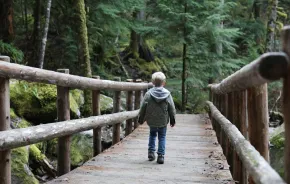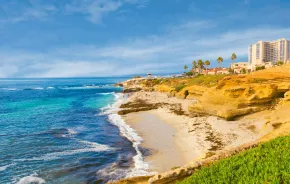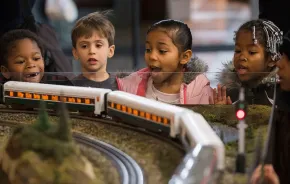The kids had been hiking for hours. In fact, the further we went, the more their enthusiasm grew. They raced ahead of us on the trail, checking their "computers" and shouting out the displayed numbers. We parents hung back, relishing their excitement and basking in the July sunshine filtering through the leaves. But when we reached our destination, the thrill overtook all of us as we fanned out and started eagerly climbing over boulders, looking in stumps, even digging in the dirt and leaves.
"I found it! I found it!" somebody shouted. Children and parents alike ran to see what buried treasures we had unearthed. Sifting through the contents of the watertight container, we soon discovered there was something for everyone, and we each left a possession of our own behind in exchange. We finished our first geocache hunt, and we knew we were all hooked.
Geocaching started in May 2000, when the U.S. government eliminated restrictions on the use of its global positioning system (GPS) signals. A Seattle man soon placed a notebook inside a canister, stashed it in the woods outside Portland and e-mailed the GPS coordinates to a friend.
Today there are over 100,000 geocaches in more than 200 countries. Thousands of those are right here in the Puget Sound area, carefully concealed in publicly accessible places like local parks and hiking trails. To find them, you need Internet access to get the GPS coordinates of their hiding places, and you need a basic handheld GPS unit, available for just over $100 at local sporting goods stores.
It may seem deceptively easy since you're given the exact coordinates of the geocache, but remember that you don't necessarily know how to get there. You could find paths, highways, forests, hills, mountains, lakes, streams, buildings or even people between you and the coordinates.
"As the crow flies" will probably not be your best route, and you might need to get a little creative. In addition, GPS coordinates are only accurate to within 6-20 feet, and that can make for a lot of ground to cover in search of a hidden treasure!
Because of that uncertainty, the key to successfully geocaching with children is preparation. First, go to www.geocaching.com and enter your zip code to get a list of the caches hidden in your area. Find some geocaches that interest you and read their descriptions carefully.
Choose traditional caches with one or two stars in the difficulty and terrain ratings to help ensure an easy and fun family outing. Then, pack everything you need to be safe and comfortable on a long hike over varied terrain, such as sunscreen, rain gear, clothing layers, drinks, food, maps and a first aid kit.
If your children are very young, be sure to bring an appropriate child carrier in case they get tired. Finally, help your child find some small items that he or she might be willing to trade. Some items frequently found in geocaches include maps, postcards, money, jewelry, tools, souvenirs, stickers or small toys.
The rules of geocaching are simple: Take something from the geocache, leave something in its place and sign the logbook to record your experience.
The rewards of geocaching go far beyond the material treasures your kids might find. Lessons in geography, map reading, nature, ecology, physical exercise and the Golden Rule are all easy to impart when you share this exciting hobby with them.
Resources:
Geocaching -- The Official Global GPS Cache Hunt Site
Washington State Geocaching Association
Letterboxing North America (clue-based, no GPS required)
This article originally appeared in the August, 2004 issue of ParentMap.









